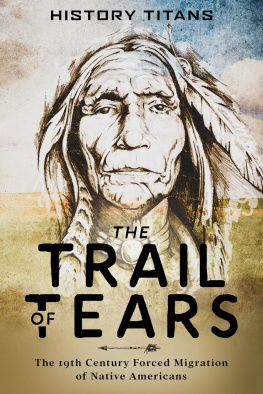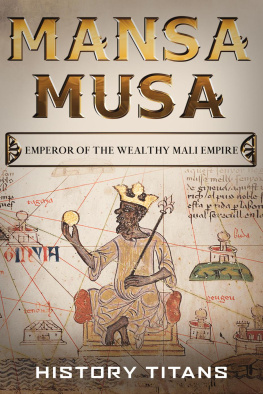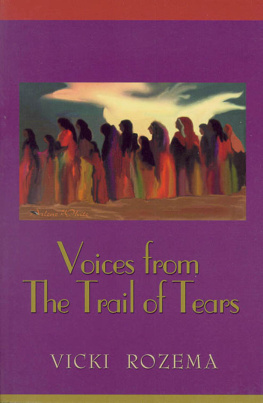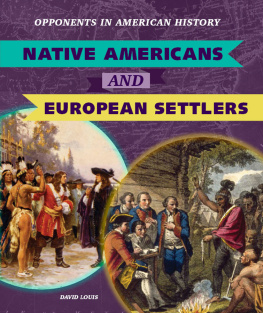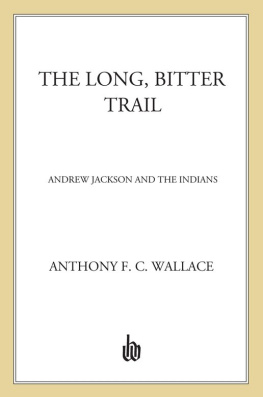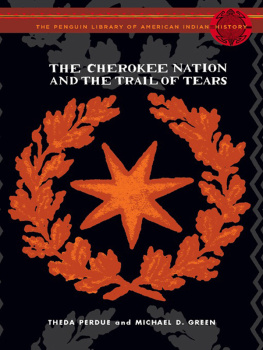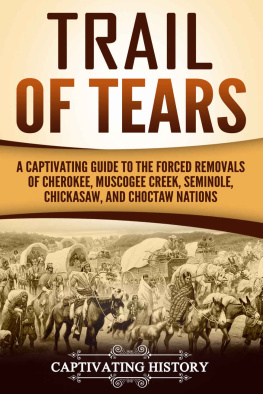The Trail of Tears
The 19th Century Forced Migration of Native Americans
Copyright 2020 - All rights reserved.
The content contained within this book may not be reproduced, duplicated or transmitted without direct written permission from the author or the publisher.
Under no circumstances will any blame or legal responsibility be held against the publisher, or author, for any damages, reparation, or monetary loss due to the information contained within this book, either directly or indirectly.
Legal Notice:
This book is copyright protected. It is only for personal use. You cannot amend, distribute, sell, use, quote or paraphrase any part, or the content within this book, without the consent of the author or publisher.
Disclaimer Notice:
Please note the information contained within this document is for educational and entertainment purposes only. All effort has been executed to present accurate, up to date, reliable, complete information. No warranties of any kind are declared or implied. Readers acknowledge that the author is not engaging in the rendering of legal, financial, medical or professional advice. The content within this book has been derived from various sources. Please consult a licensed professional before attempting any techniques outlined in this book.
By reading this document, the reader agrees that under no circumstances is the author responsible for any losses, direct or indirect, that are incurred as a result of the use of information contained within this document, including, but not limited to, errors, omissions, or inaccuracies.
Table of Contents
T he Trail of Tears is a fascinating story that revolves around the forced removal of the Native Americans from their ancestral lands in the United States in the 19th century. The tale of Native Americans is one of the most famous genocide anecdotes in world history.
Native Americans are known by various names such as Indigenous Americans, American Indians, and the Indigenous people of the United States (apart from Hawaii). They inhabited the entire region of the American continent and surrounding regions, right from the Arctic point to the tip of the southern American continent. Several tribes settled in one region and distributed parts of their land to live on and cultivate. During their time, they built temples to worship and developed a structured lifestyle pattern. Other tribes or nomads traveled across the flat lands of the continent.
To understand the occurrence and consequences of the Trail of Tears, it is necessary to first learn about the significant parts of the history of Native Americans - where they came from, how they were controlled, and the consequences. It's also important to learn about the European settlers that invaded the Indian land and enforced brutal acts over the tribal people.
This book will cover all aspects related to the removal of the Native Americans from their homelands, in detail. You will also gain an overview of their history, how they settled in their native lands, the role of American leaders in deciding their fate, and how the heinous removal act was later known as the Trail of Tears. The last chapter also provides an insight into the repercussions and the current scenario of the natives. Read on to find out.
Chapter 1: History of the Native Americans
T his chapter covers the entire history of Native Americans - how they settled in their lands, how they grew, and how they were oppressed by the colonizers. It is necessary to understand their history before moving on to the Trail of Tears directly; this is because Native Americans have been marginalized to a great extent. Whether it is geographical or metaphorical, people have forgotten about the Native Americans. Those who know about it connect to their story with a sense of pity or revile.
Also, this group of people formed a small percentage of groups that resisted oppression and fought for their freedom - not once, but multiple times. Moreover, Native Americans also displayed an example of how you could act in historical dominance and not be acted upon.
Native Americans lived in the southern parts of the territory and occupied most of the fertile land for several generations. The name 'Indians' was denoted by Christopher Columbus when he mistakenly believed that he had landed in the Indies. Columbus landed on the American land in 1492, where millions of people belonging to the indigenous tribes inhabited the region. With the advent of 1900, less than 300,000 people survived in the region.
During the later stages of the Ice Age, several inhabitants in Siberia traveled to Alaska through the Bering Land Bridge, which was a stretch of land that connected Siberia to Alaska. This stretch of land was a difficult journey to cover as it was inhabited by several animals, some of which were dangerous. The journey was not limited to only one group. Many groups of varying ethnicities traveled across the stretch and settled around the regions over the next thousands of years. This is proven by the archaeological remains of prints, animal parts related to bison, moose, elk, and mammoth, tools, and evidence of fire pits in the regions. The evidence dates back to 14,500 years ago, which is almost at the end of the Ice Age. It is also known that these people were avid craftsmen who developed specialized tools to hunt big animals for meat and fur.
As time passed, they started moving to the southern parts of the Alaskan region, which eventually led them to Mexico and other parts of the United States. As generations passed, their descendants explored and started settling around the western coast of the United States. By 1000 BC, most of these inhabitants settled in and around the continent of North America. Some of these tribes continuously migrated from one continent to the other for over one thousand years. Due to their constant migration, they developed several languages, cultures, and even civilizations. These native Indian Americans belonged to different tribes and continents, mainly in Asia, Europe, and Africa.
One of the first groups of Native Americans, the Paleo Indians, would often hunt mammoths and mastodons. Next, the Archaic Indians (they survived around the period of 5000 to 1000 BC) would hunt bison or American buffalos in the Colorado plains and be proficient in developing cave art. Slowly and steadily, most of these groups converted into an agricultural society.
As soon as the Ice Age ended, the Native Americans further developed smaller groups or tribes that followed a particular language, culture, and habitat. They used the natural resources that were available to them and developed an agricultural and farming base. They grew crops like squash and corn and tended to farm animals such as Guinea Pigs, llamas, and turkeys for food and other lifestyle requirements. Their protein and meat intake was also fulfilled by hunting animals like deer, sea mammals, bison, and fish. They formulated their own method to hunt and to catch fish.
Next page
